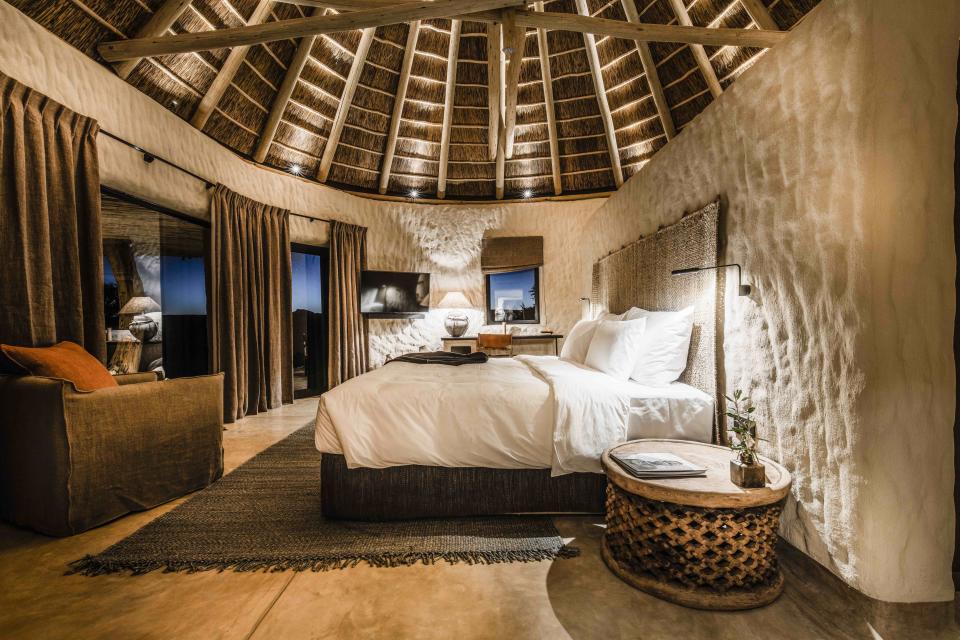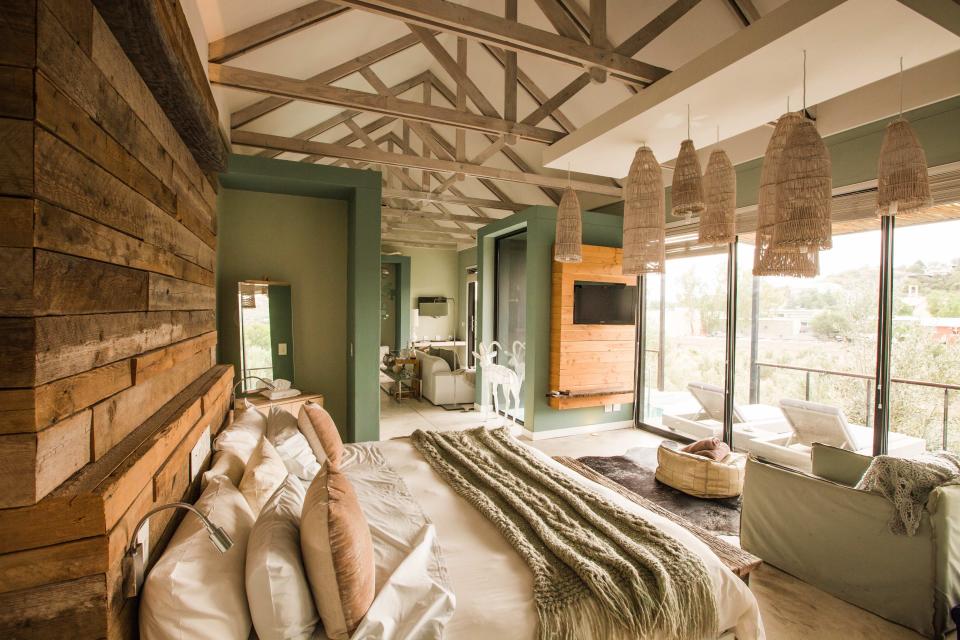Discover Namibia's Stunning Landscapes, Wildlife, and Architecture
Flying into Windhoek, Namibia, feels like soaring over a papier-mâché globe, a tonal spread of lumpy mountains and unforgiving desert on which there’s hardly evidence of life. Tiny architectural-model-like structures and stick-straight roads cutting through nothingness are few and far between, and occasionally there’s a spray of dry looking bushes. The sky is a smoky pale blue, the color fading into the neutral hues of the earth as it reaches the horizon. Even on the ground, there are a few surprising lush palms at the airport, and beyond masses of tall brown grasses, puffs of green trees, and messes of sticklike bush.

901578082
Elsewhere in the vast country two times the size of California (but with half the total population of Los Angeles) is the world’s highest sand dune, oldest desert, and a coastline scattered with bleached whale skeletons and the pink sand of ground garnet. So when this stark terrain gives way to an architecturally compelling luxury safari lodge or boutique hotel, it pops. And the opening of several new properties has undeniably changed the landscape, and appeal, of Namibia, which only got its name (it was South West Africa, controlled by South Africa) in 1990. Luxury travel operator Scott Dunn and their local partner ATI Holidays have recently noticed an uptick in interest and requests. One of the stablest, most peaceful, and inclusive African nations, it’s increasingly attracting travelers for its awe-inspiring natural beauty and truly wild fauna (the world’s largest free-roaming black rhino population, for one).

There are fascinating design elements to witness, too. Check out a traditional Himba village—the least modernized of the tribes harnesses plants and earthen elements like ochre to coat their skin—to duck inside low-profile huts made of mopane branches coated inside and out with dried cow dung. These contrast starkly with the far larger Ovambo tribe–inspired huts of Omaanda, the first of two Zannier Hotels property to open, just a few months ago, in Africa. They were built on the savannah using traditional sandbag construction, creating a pleasing modeled surface on the rounded walls, with hand-finished thatch roofs. Nowhere is a giant picture more exciting than beside the large bathtub, which overlooks a water hole drawing wildlife to drink. The decor of each hut and the restaurant, infinity pool and deck, and lounge celebrates a sense of place, with safari-chic neutrals, indigenous artifacts, African antiques and custom-made furnishings. The partner of N/a’an ku sê Wildlife Sanctuary next door make the perfect first and last stop—it’s just 30 minutes from the airport—a sort of bridge between the utter wild found farther afield.

Namibia
In Windhoek, the Olive Exclusive teases what’s to come in a visual sense, with breathtaking large-format photography by South Africa’s Mickey Hoyle, who dreamed up the transportive interiors of the bijou bolthole, where each suite is uniquely styled, surrounded by olive trees and bougainvillea, and the lounge offers immersion into the kind of rich, masculine African aesthetic one craves. To bring that aesthetic home—or stunning photography of the surrounds—there’s the Namibia Craft Centre, where handicrafts, artwork, and curios by ethnic tribes and rural communities are sold in a mellow zero-pressure environment (think vibrantly painted papier-mâché “trophies,” embroidered pillowcases, block-printed textiles and carved wood and horn.

Along with Omaanda, a few other new lodges have seriously stepped up the country’s profile when it comes to aesthetics. Serra Cafema Camp, in the extreme northwest of Namibia on the Kunene River in Hartmann’s Valley, just reopened with an environmentally sensitive rebuild, with fresh architecture designed to showcase the otherworldly desertscape around it. It’s meant to reflect the structure of a Himba village, and has an oval seating area designed for stargazing modeled after the area the tribe traditionally gathers around its sacred fire, and guest rooms that feature sunken seating, canopy beds, and stone accents sourced from the valley. Leather and wood pieces were commissioned by groups giving Namibian orphans and previously unskilled laborers training and jobs.

Portra 160 rated 125
On the Skeleton Coast, magical yet eerie in its emptiness, solitude, and vastness, the newly built Shipwreck Lodge, designed by a Namibian architect and interior design team, manages to complement those qualities with its charming asymmetrical shiplike cabins built on wind-shaped sand above the wide beach. The only luxury accommodation for miles and miles, it’s appropriately cozy for a place where one might experience four seasons in a day, with faux-fur blankets, wood-burning stoves, and nautical and oceanic touches (see portholes in the wood-clad bathrooms, and elements made of recycled wood, rope and linen with found shells and stones). Drives here are not so much about seeing game but rather are breathtaking environmental studies into geology and flora, though these dramatic backdrops make the sighting of a desert-adapted elephant or oryx all the more unique.

Portra 400
A wild all-day drive down a dry riverbed and through plains, savannah, pastel mountains, and mirages connects Shipwreck with its also eco-friendly sister property Hoanib Valley Camp, the luxury tented property tucked behind towering granite mountains in a wildlife-rich zone with a different yet equally dramatic landscape. There, Cate Simpson of Reflecting Africa (who designed North Island in the Seychelles) used inspiration from the environs for bespoke furniture and cushions, ombre-dyed curtains and locally carved wood. Prince William recently slept in the largest tent when he visited to support Giraffe Conservation Foundation. Nights are spent sipping Namibian gin and tonics around the fireplace and gazing at stars before tucking into silky sheets warmed by a hot water bottle, which lead to more adventures tracking rhino, observing elephants, and spotting zebra, giraffe, and springbok across incomprehensible terrain. It’s the Namibian way.

